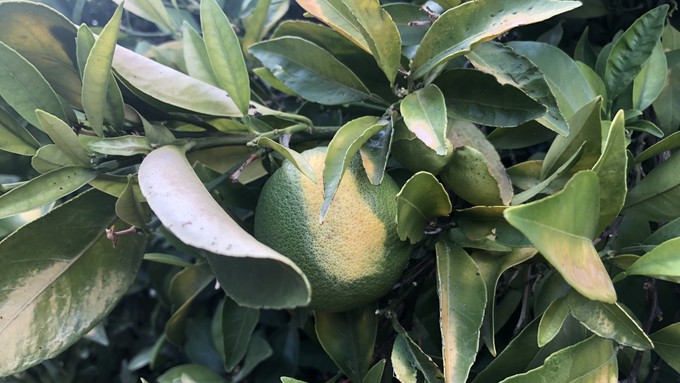
Delta breeze brings some relief after epic heat wave

Gardeners probably all feel like this poor navel orange, after more than a week of 100-degree-plus temperatures: Scorched. Kathy Morrison
Relief! The Delta Breeze never felt so good!
Onshore flow of cooler air has finally brought an end to the worse early September heat wave in Sacramento history.
How hot was it? According to the National Weather Service, Downtown Sacramento averaged 108.8 degrees over September’s first nine days, topping the old record for that period (101.1, set in 1923) by 7.7 degrees. Normal for the first two weeks of September: 92.6.
Our overnight lows set a record high, too, averaging 71.1 degrees over the first nine nights in September. This month often is pretty warm at night; the old high-low record was 69.7, set in 1998. Average for this time period: 60. 8.
“It was quite the start to September for #NorCal with a historic heat wave,” tweeted the Sacramento NWS office. “This helped bring the hottest start to the month of September on record for interior Northern California with the average high so far for Sacramento at 108.8 and 109.8 for Redding.”
Sacramento International Airport set daily records with new highs on six consecutive days, Sept. 4-9.
What a difference a little ocean breeze makes! The weather service predicts high temperatures 20 degrees or more cooler than last week. The forecast high for Wednesday: 81 degrees.
Sacramento is expected to stay comfortably in the 80s through next weekend. Instead of heat, the challenge now will be smoke from nearby wildfires. But forecasters anticipate the onshore flow will push most of the haze east, out of Sacramento.
What to do now that you can venture outdoors?
* Start by rinsing off your plants. Sticky residue from smoke can stick to leaves and clog pores, inhibiting their ability to “breathe.” This also will help get rid of spider mites, which have been loving this dry heat.
* Now is the time to plant for fall. Warm soil will get these veggies off to a fast start.
* Keep harvesting tomatoes, peppers, squash, melons and eggplant – if you have any. Wash veggies well to remove smoke residue.
* Compost annuals and vegetable crops that have finished producing.
* Cultivate and add compost to the soil to replenish its nutrients for fall and winter vegetables and flowers.
* Fertilize deciduous fruit trees.
* Plant onions, lettuce, peas, radishes, turnips, beets, carrots, bok choy, spinach and potatoes directly into the vegetable beds.
* Transplant cabbage, broccoli, kale, Brussels sprouts and cauliflower as well as lettuce seedlings.
* Sow seeds of California poppies, clarkia and African daisies. Transplant cool-weather annuals such as pansies, violas, fairy primroses, calendulas, stocks and snapdragons.
* Divide and replant bulbs, rhizomes and perennials.
* Dig up and divide daylilies as they complete their bloom cycle.
Comments
0 comments have been posted.Sacramento Digs Gardening to your inbox.
Sites We Like
Garden Checklist for week of July 21
Your garden needs you!
* Keep your vegetable garden watered, mulched and weeded. Water before 8 a.m. to reduce the chance of fungal infection and to conserve moisture.
* Feed vegetable plants bone meal, rock phosphate or other fertilizers high in phosphate to stimulate more blooms and fruiting. (But wait until daily high temperatures drop out of the 100s.)
* Don’t let tomatoes wilt or dry out completely. Give tomatoes a deep watering two to three times a week.
* Harvest vegetables promptly to encourage plants to produce more. Squash especially tends to grow rapidly in hot weather. Keep an eye on zucchini.
* Pinch back chrysanthemums for bushy plants and more flowers in September.
* Remove spent flowers from roses, daylilies and other bloomers as they finish flowering.
* Pinch off blooms from basil so the plant will grow more leaves.
* Cut back lavender after flowering to promote a second bloom.
* It's not too late to add a splash of color. Plant petunias, snapdragons, zinnias and marigolds.
* From seed, plant corn, pumpkins, radishes, winter squash and sunflowers.